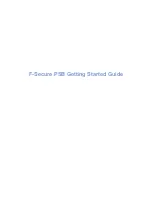
Programming
93
NetLinx Studio (v2.4 or higher)
Supported Regular Expression Special Characters
The following regular expression special characters are supported for Regular Expression search
operations:
Cut, Copy And Paste
NetLinx Studio supports Cut, Copy and Paste functionality in the Source Code Editor:
Select
Edit > Cut
(or click the toolbar button) to cut the selected text to the clipboard.
Select
Edit > Copy
(or click the toolbar button) to copy the selected text to the clipboard.
Select
Edit > Paste
(or click the toolbar button) to Paste the contents of the clipboard to
the active file, at the cursor position.
Delete Word
deletes the current word at the cursor
Delete Word Left
deletes from the cursor to the start of the word
Delete Word Right
deletes from the cursor to the end of the word
Delete Line
deletes the current line at the cursor
Delete Line Left
deletes from the cursor to the beginning of the line
Delete Line Right
deletes from the cursor to the end of the line
None of these commands have default keyboard hotkeys assigned. To assign
hotkeys, use the Keyboard tab of the Preferences dialog (select Advanced Editor
from the Category drop-down list).
Special Character Description
.
Matches on any character.
\(
This marks the start of a region for tagging a match.
\)
This marks the end of a tagged region.
\n
Where n is 1 through 9 refers to the first through ninth tagged region when
replacing. For example: if the search string was Fred\([1-9]\)XXX and the
replace string was Sam\1YYY, when applied to Fred2XXX this would gener-
ate Sam2YYY.
\<
This matches the start of a word.
\>
This matches the end of a word.
\x
This allows you to use a character x that would otherwise have a special
meaning. For example: \[ would be interpreted as [ and not as the start of a
character set.
[...]
This indicates a set of characters. For example: [abc] means any of the char-
acters a, b or c. You can also use ranges. For example: [a-z] for any lower
case character.
[^...]
The complement of the characters in the set. For example: [^A-Za-z] means
any character except an alphabetic character.
^
This matches the start of a line (unless used inside a set, see above).
$
This matches the end of a line.
*
This matches 0 or more times. For example: Sa*m matches Sm, Sam, Saam,
Saaam and so on.
+
This matches 1 or more times. For example: Sa+m matches Sam, Saam,
Saaam and so on.
Summary of Contents for NETLINX STUDIO V2.4
Page 1: ...instruction manual Software NetLinx Studio v2 4 or higher ...
Page 16: ...NetLinx Studio v2 4 or higher 4 NetLinx Studio v2 4 or higher ...
Page 32: ...The NetLinx Studio v2 4 Work Area 20 NetLinx Studio v2 4 or higher ...
Page 44: ...Working With Workspace Files 32 NetLinx Studio v2 4 or higher ...
Page 88: ...Working With Systems and System Files 76 NetLinx Studio v2 4 or higher ...
Page 118: ...Programming 106 NetLinx Studio v2 4 or higher ...
Page 152: ...Working With Online Devices 140 NetLinx Studio v2 4 or higher ...
















































